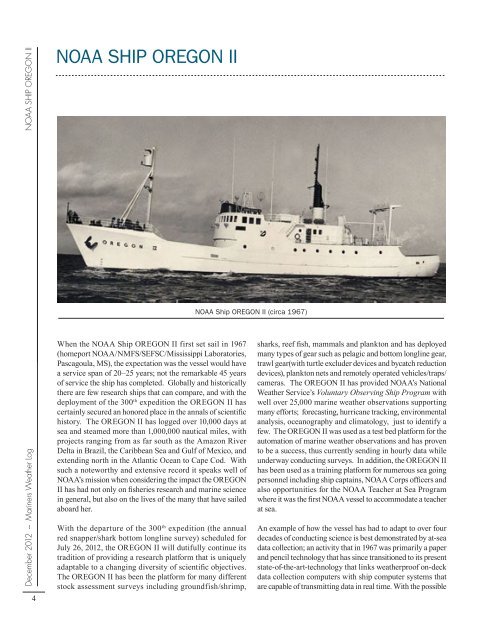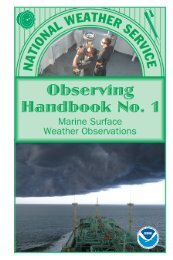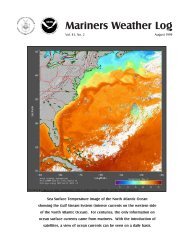Volume 56, Number 3 December 2012 Photo by Denice Drass
Volume 56, Number 3 December 2012 Photo by Denice Drass
Volume 56, Number 3 December 2012 Photo by Denice Drass
You also want an ePaper? Increase the reach of your titles
YUMPU automatically turns print PDFs into web optimized ePapers that Google loves.
NOAA Ship OregON ii<br />
<strong>December</strong> <strong>2012</strong> ~ Mariners Weather Log<br />
4<br />
NOAA ShiP OrEgON ii<br />
When the NOAA Ship OREGON II first set sail in 1967<br />
(homeport NOAA/NMFS/SEFSC/Mississippi Laboratories,<br />
Pascagoula, MS), the expectation was the vessel would have<br />
a service span of 20–25 years; not the remarkable 45 years<br />
of service the ship has completed. Globally and historically<br />
there are few research ships that can compare, and with the<br />
deployment of the 300 th expedition the OREGON II has<br />
certainly secured an honored place in the annals of scientific<br />
history. The OREGON II has logged over 10,000 days at<br />
sea and steamed more than 1,000,000 nautical miles, with<br />
projects ranging from as far south as the Amazon River<br />
Delta in Brazil, the Caribbean Sea and Gulf of Mexico, and<br />
extending north in the Atlantic Ocean to Cape Cod. With<br />
such a noteworthy and extensive record it speaks well of<br />
NOAA’s mission when considering the impact the OREGON<br />
II has had not only on fisheries research and marine science<br />
in general, but also on the lives of the many that have sailed<br />
aboard her.<br />
With the departure of the 300 th expedition (the annual<br />
red snapper/shark bottom longline survey) scheduled for<br />
July 26, <strong>2012</strong>, the OREGON II will dutifully continue its<br />
tradition of providing a research platform that is uniquely<br />
adaptable to a changing diversity of scientific objectives.<br />
The OREGON II has been the platform for many different<br />
stock assessment surveys including groundfish/shrimp,<br />
NOAA Ship OrEgON ii (circa 1967)<br />
sharks, reef fish, mammals and plankton and has deployed<br />
many types of gear such as pelagic and bottom longline gear,<br />
trawl gear(with turtle excluder devices and <strong>by</strong>catch reduction<br />
devices), plankton nets and remotely operated vehicles/traps/<br />
cameras. The OREGON II has provided NOAA’s National<br />
Weather Service’s Voluntary Observing Ship Program with<br />
well over 25,000 marine weather observations supporting<br />
many efforts; forecasting, hurricane tracking, environmental<br />
analysis, oceanography and climatology, just to identify a<br />
few. The OREGON II was used as a test bed platform for the<br />
automation of marine weather observations and has proven<br />
to be a success, thus currently sending in hourly data while<br />
underway conducting surveys. In addition, the OREGON II<br />
has been used as a training platform for numerous sea going<br />
personnel including ship captains, NOAA Corps officers and<br />
also opportunities for the NOAA Teacher at Sea Program<br />
where it was the first NOAA vessel to accommodate a teacher<br />
at sea.<br />
An example of how the vessel has had to adapt to over four<br />
decades of conducting science is best demonstrated <strong>by</strong> at-sea<br />
data collection; an activity that in 1967 was primarily a paper<br />
and pencil technology that has since transitioned to its present<br />
state-of-the-art-technology that links weatherproof on-deck<br />
data collection computers with ship computer systems that<br />
are capable of transmitting data in real time. With the possible






